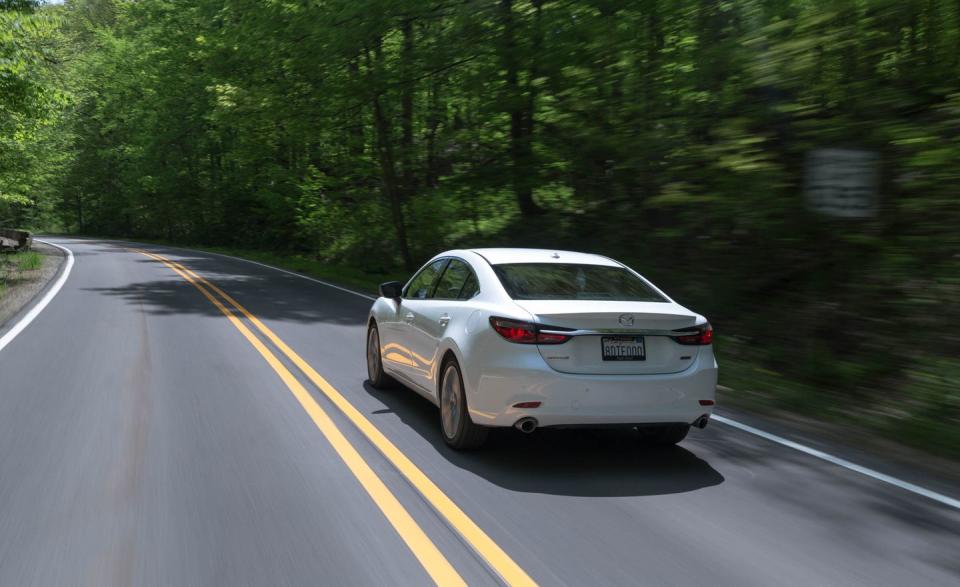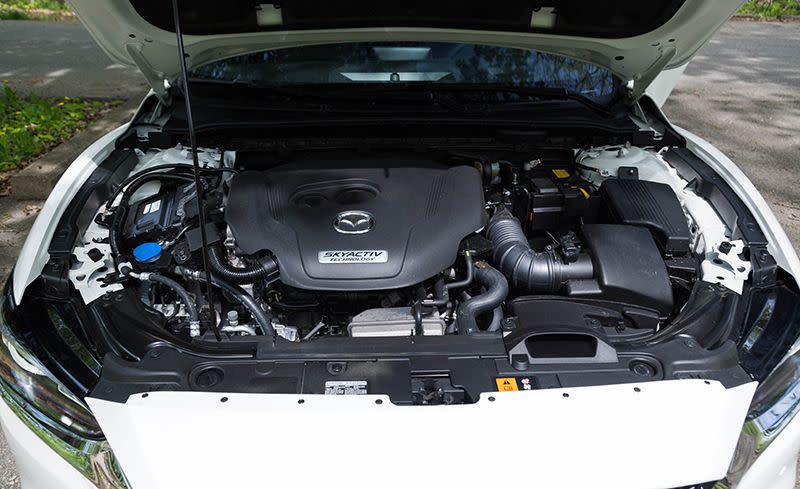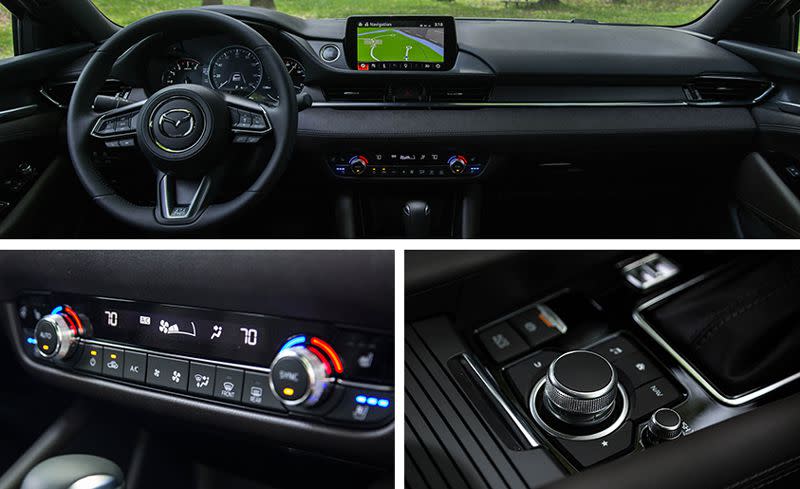2018 Mazda 6 Turbo Tested: The Silence of the Cams

It’s possible that the 2018 Mazda 6 will be best remembered for what it doesn’t do. Though it retains much of the lovable character of most Mazdas-purity in operation and communication-it also greatly diminishes one fault that, in recent years, became the brand’s most glaring flaw: noise. Indeed, the new 6 is quieter at 70 mph than both the 2016 model and the Honda Accord Touring 2.0T, a fact made possible by more than 70 noise-reducing changes to this revised 2018 model.
So extensive are the NVH improvements that even the Mazda 6’s doorsills receive seals to keep noise from penetrating the cabin. Starting at the source, new 19-inch Falken tires (17-inch Yokohamas on Sport models) reduce tire howl, and stiffer wheels help quell sound transmission. Tracing the path of noise into the cabin, Mazda tuned the harmonics of the subframes, floorpan, and front struts to attenuate din-creating frequencies. Additional sound deadening quiets some 20 body panels, the doors, and the firewall. Higher trims are further hushed by acoustic laminated glass in the front side windows. Mazda even resculpted the leading edge of the B-pillars to reduce wind noise.
It all amounts to a thorough aural rethink and an iron curtain for commotion. But if you’ve never thought twice about noisy Mazdas, then possibly you’ll care more about the 6’s other changes. New for 2018 and standard in Grand Touring and higher trims (we tested the range-topping Signature here) is the turbocharged 2.5-liter inline-four from the CX-9. It shares its two power ratings-227 horsepower on 87-octane fuel and 250 on 93-with Mazda’s biggest crossover, too. Sport and Touring models still get the old 2.5-liter inline-four, now making 187 horsepower (up three from last year). A six-speed manual comes only with the Sport trim, and all others get the excellent Mazda-built six-speed automatic. Every Mazda 6 is front-wheel drive.
The turbocharged powertrain reinforces the newly subdued nature of the car itself. The philosophy behind the engine, or, more specifically, its power delivery, is to match the rate of acceleration and the timing of the acceleration to exactly what the driver is expecting based on input at the pedal. Of course, all engines should respond predictably to driver inputs. But here, a radical engine tune feels decidedly unradical. The result of 310 lb-ft of torque all the way down at 2000 rpm is-wait for it-fewer downshifts. Should the urge to drive with purpose arise, engage Sport mode or shift the 6 yourself using the shift lever or, if you have a Grand Touring model or better, the wheel-mounted paddles.
So, we’ve got an engine that’s intentionally lacking zing from a company that prides itself on zoom. That might have worked in an SUV, but here, in Mazda’s top sedan, it feels as if something is missing. It could be acceleration: Sixty miles per hour arrives in 6.4 seconds. For reference, the Honda Accord Touring 2.0T needs only 5.5 and the V-6–powered Toyota Camry XSE requires 5.8. The now 200-pounds-heavier 6 rounds the skidpad at only 0.81 g and stops from 70 mph in a marginal-at-best 184 feet; both numbers are worse than the 2016 model’s. They’re also worse than the Accord Touring 2.0T’s figures-that car pulls 0.88 g and stops in only 170 feet. Those quiet tires, it seems, come with compromises. Still, the 6’s combination of immediate torque and fewer gears has it easily ahead of both the Honda and Toyota in 30-to-50-mph and 50-to-70-mph acceleration, where Mazda’s claim to responsiveness is best substantiated. And rolling acceleration, so essential for merging and passing, is arguably a more important metric than standing-start launches for a mid-size sedan.
Even so, the 6 isn’t a numbers car. Mazda, perhaps defiantly, isn’t a company that builds cars to achieve numbers. So the 6 doesn’t do that. As a mid-size sedan, it will be a people hauler and a daily commuter. And in those arenas, it flourishes. Particularly if its owners care about ride-handling balance. In fact, Mazda’s 6 rides more comfortably than the pleasant, if tightly drawn, CX-5. And it still handles better than you’ll ever need it to, with accurate steering-thanks in part to a solid-mounted steering rack- and sorted communication from the body and chassis. Redesigned dampers with rebound springs better control roll without compromising straight-line comfort, as bigger anti-roll bars would have done. New spring perches and excruciating detail work in the bushings help reduce friction in the suspension. The 6’s handling game is sufficient to show the occasional on-ramp who’s boss.
It’s also restyled, though you’ll need to be intimately familiar with the outgoing car to see the differences. All the stylists’ talk is happening here: It looks lower, wider, and more aggressive, even though the car’s overall dimensions haven’t changed. Mazda swapped the previous 6’s horizontal grille slats for a mesh design. But in the end, the 6 remains the sculpted, bulging machine it has been since its 2012 introduction.
There’s a refurbed interior to go with the newfound silence as well. A strong centerline now divides the dash horizontally and extends into the doors. HVAC controls slim down, and ventilated seats-a first for Mazda-make an appearance on the two highest trims. Signature models get stitched synthetic suede and Japanese sen-wood inserts, which easily elevate the interior to BMW 3-series and Audi A4 levels. It’s worth mentioning the four knobs Mazda uses to manage volume, temperature, and secondary infotainment controls because, well, that’s the right way to do it.
The 6 starts at $22,840 for a Sport with the manual transmission and climbs to $35,640 for a Signature model. That’s more than a $4000 bump over last year’s range-topping Grand Touring trim. We can’t ignore the fact that the 6’s powerplant exempts itself from high-speed play under the pretense of response and still accept the sedan as wholly fulfilling Mazda’s mission to involve drivers. But it’s even harder to say Mazda’s new 6 isn’t a stunning, unexpectedly luxurious, and reasonably fun machine to drive.
You Might Also Like

 Yahoo Autos
Yahoo Autos 


